The Department of Yonne in Burgundy is one of our favorite places in France and very fertile for our photographic explorations. It is home to the Basilique Sainte Madeleine in Vézelay, the Cathédrale Saint-Étienne in Auxerre, the Collégliale Saint Lazare in Avallon and also the Cathédrale Saint-Étienne de Sens.
Today, Sens is a fairly quiet town of about 27,000 people, the second most important of the Yonne after Auxerre. One would have no idea from its current state just how important Sens was in the Middle Ages as the seat of the “Primate of Gaul,” perhaps the most important bishop in France and superior to the bishopric of Paris. For much of the early Middle Ages, the Kings of France were anointed here, not at Reims.
Sens was the capital of an ecclesiastical province composed of several neighboring dioceses and headed by a metropolitan, the archbishop designated by the Pope. At its height, the Archdiocese of Sens counted seven suffragans – subordinate bishops – at Chartres, Auxerre, Meaux, Paris, Orléans, Nevers, and Troyes. Only in 1622 was Paris raised to the status of a Metropolitan See and Chartres, Orléans, and Meaux were separated from Sens.
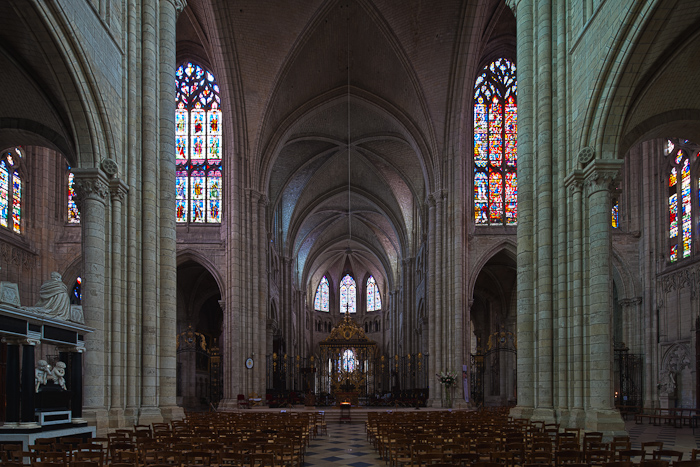
Sens was an important settlement long before the Middle Ages. It was the site of an oppidum of the Senones, a Celtic tribe of Gaul. Caesar called it Agedincum and it later became an administrative center of Roman Gaul, situated at the intersection of the roads from Troyes to Orléans and Lyons to Paris . The first recorded Christian activity on the site was founded by the Saints Savinian and Potentian, sent by the Bishop of Rome in the 4th Century to proselytize the Gauls. They were martyred in 390. Their church was rebuilt in the sixth or seventh century. In 731, the Saracens ranged far enough north that they besieged the town, which was rescued by its bishop.
In the ninth century, the earlier church was succeeded by a Carolingian edifice, but this burned in 982. The church was immediately reconstructed by the Bishop Seguin and consecrated a few years later.
Around 1135, the Archbishop of Sens, Henri Sanglier, decided to replace the Carolingian cathedral of the tenth century with a structure befitting the importance of the metropolitan see over which he presided. Archbishop Sanglier was a singular person in the French landscape. He was a friend of both Abbot Suger of Saint Denis and Bernard of Clairvaux. He twice gave refuge to Thomas à Becket during his struggles with King Henry II. The second time was after Becket was forced to leave the abbey of Pontigny after the English monarch threatened to close every Cistercian house in England. When he was welcomed to Sens, Becket enthused, “ô douce, encore, ô très douce France! Oui, elle est douce, vraiment douce, la France!”
At the time of Sanglier’s rebuilding, church architecture was dominated by the great Romanesque churches. Sanglier commissioned a new architect to build his new church, who proposed building with a revolutionary form of vaulting – the rib vaulting that had begun to appear in the Norman churches in France and England. Although the finished cathedral in Sens was not completed for four centuries, the main structure was the product of a single mind, Guillaume de Sens. While there is no direct documentary record, there is enough evidence that we can perhaps infer the identity of the architect.
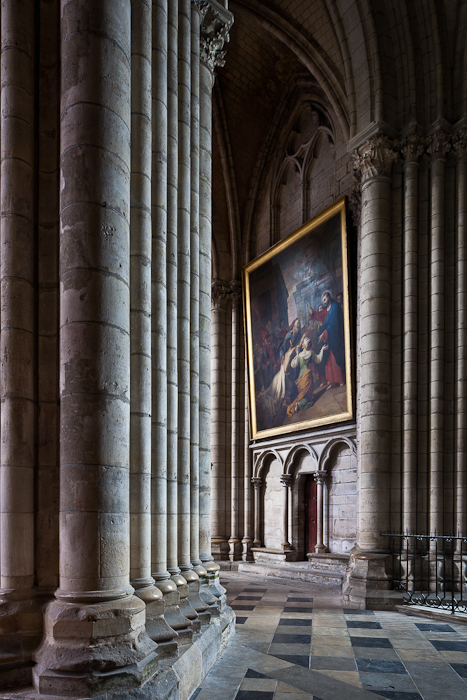
Saint-Etienne was constructed in its original form between 1135-1164 and was consecrated on 19 April 1163 by Pope Alexandre III, who was then in exile in Sens. This makes Saint-Étienne the oldest Gothic cathedral in France. The first Gothic structure is the Abbey Church of Saint Denis, built by Suger, but it did not become a cathedral until the 20th Century.
There is an interesting side note to Guillaume de Sens. Becket was at Sens during the time of the building of Saint-Étienne and when he returned to Canterbury, he made plans to rebuild the cathedral there. He was assassinated before he could do so, but the architect who was hired to build was the same Guillaume de Sens. Some historians speculate that Becket made the recommendation. In 1180 while working on the construction, Guillaume fell fifty feet from the scaffolding. Crippled, he returned home to Sens where he died soon after.
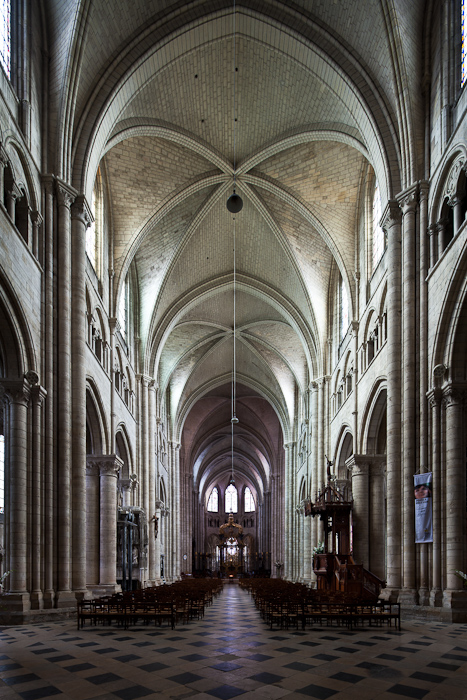
The architecture of the Cathédrale Saint-Étienne de Sens is defined by three elements – the vaulting, the width of the nave, and the style of the nave pillars and columns.
The church features early Gothic sexpartite vaulting over a modest clerestory, and may even have been the first church to be completely vaulted in this manner. Like the Romanesque churches it was designed to supplant, there was a gallery between the aisle arcades and the clerestory level.
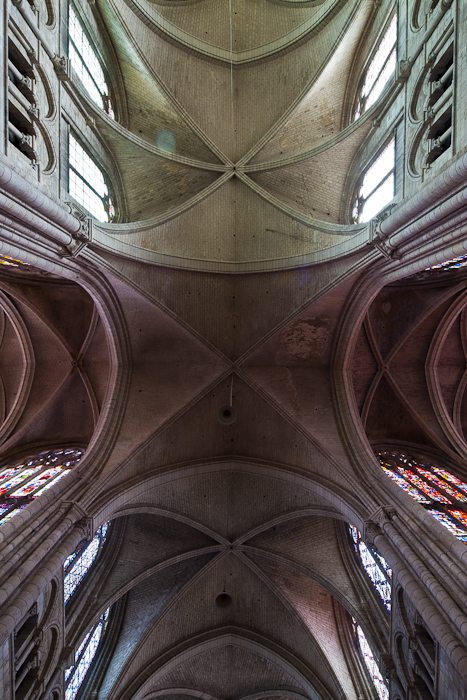
The church’s size is fairly modest, perhaps because the builders were not completely confident in the new architectural style. Saint-Étienne feels Romanesque; it is perhaps more solid than beautiful.
The interior lacks height but is very wide. A comparison with the almost-contemporary Notre Dame de Paris is telling. Sens’ length is 113.5 meters, which is smaller than Notre Dame de Paris at 128 meters. The nave height is 24.4 meters, much lower than Paris’ 33.5 meters. The width of the nave, in contrast, is 15.25 meters, almost two full meters larger than Paris. This width is one of the distinguishing factors of the Saint-Étienne de Sens. It also makes clear the builders’ intent to cover the structure with a vault, since it is too large for a wooden roof.
Finally, there is an interesting variation in the nave arcade supports – alternating piers and columns between the bays. This was not an innovation at Sens, but a very interesting stylistic choice.
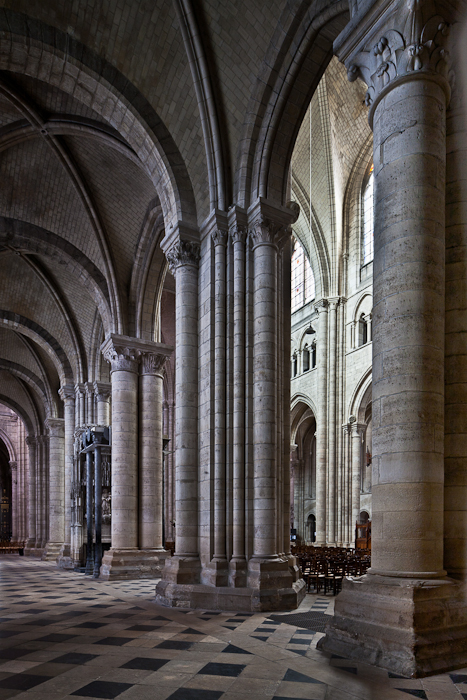
In addition to the architectural details, Sens contains some magnificent stained glass throughout the cathedral.
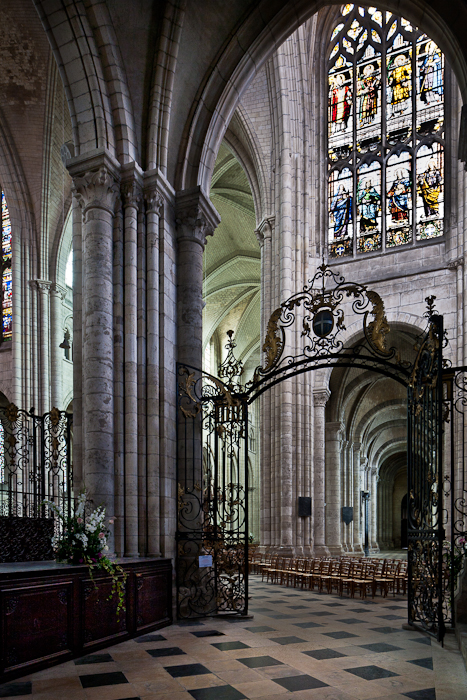
There are four in particular that are remarkable – the choir ambulatory lancets that were created at the beginning of the 13th Century, probably from Suger’s school at Saint Denis. They tell the story of Saint Eustache,the Prodigal Son, the Good Samaritan and finally the story of Thomas à Becket and his martyrdom at Canterbury.
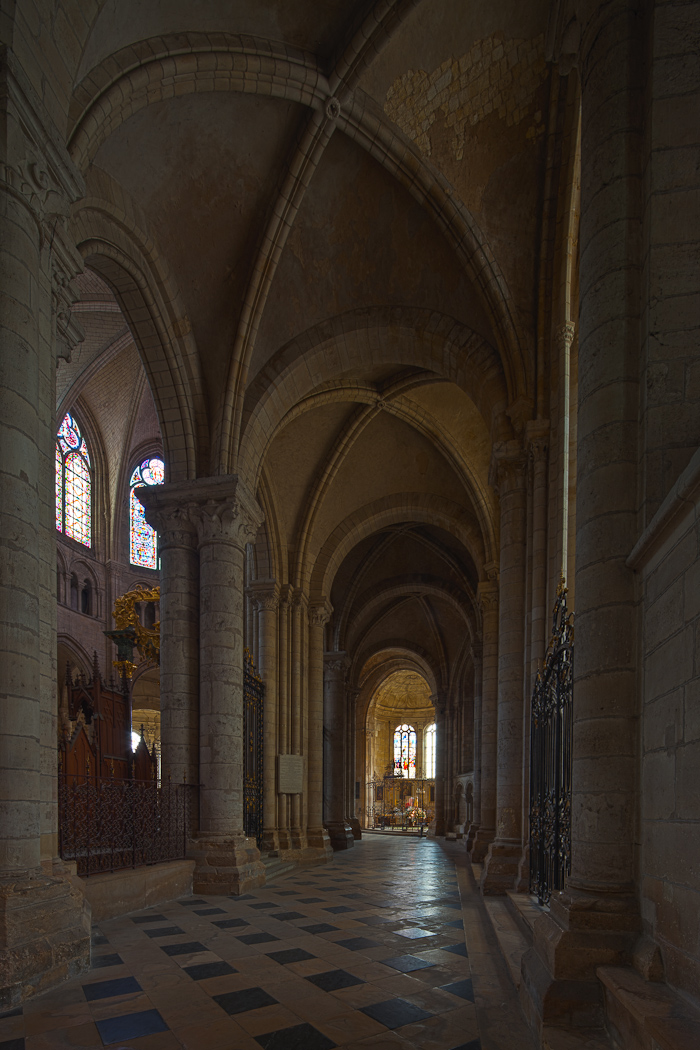
The cathedral is the heart of Sens, visible from a great distance across the Yonne plain. There is little in the modern town to suggest that it was at the center of the life in 12th Century France and home to one of the most powerful prelates in the Church. But stepping inside, we can see the care and pride of both the patron and the builder in the stone and glass of Saint-Étienne de Sens.
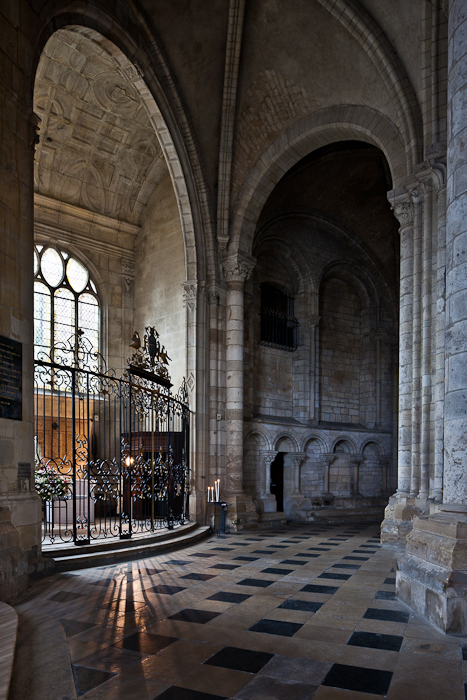

Your images are always so sharp! Love that last one especially.
Thanks, Jo. PJ’s last image is great, thought it was a fitting way to end the post.
me too! There’s a teaser here: “In 731, the Saracens ranged far enough north that they besieged the town, which was rescued by its bishop.” HOW did he rescue the town? I have visions of a robed arcbishop, single-handedly wielding a sword toforce back the besieging hordes! There has to be a good story there.
He apparently pulled together a military force and attacked the Saracens, driving them off. Don’t have all the details but am so tempted to make them up!
Very well researched and written. Thank you!
Thanks, Vann. We enjoy the research – part of it happens before we shoot and the rest when we do an article. I wish we had time to research before-hand even more, but we run out of time. We missed getting good shots of the Thomas a Becket windows.
A marvelous post on Sens with beautiful photographs and a rich history!
The sexpartite vaulting of the nave of Sens must be one of the most perfectly built during the decades preceding the glory of quadrupartite vaultings of Chartres and Amiens. I look forward to more of your enlightening posts in the new year. Jong-Soung
Jong-Soung, Merry Christmas and Happy New Year. So nice to hear from you and glad you liked the post. It’s an interesting cathedral for many reasons – there has been some scholarly discussion as to whether or not the original builder intended to use the sexpartite vaulting at all.
The architecture is as complex and grand as the story behind it.
It is grand, isn’t it, Annie. Thanks for your visit.
The essence of the Gothic architecture is well captured in these great images. And what a rare situation to have no visitors in your images.
Patience is a virtue, and never more so than when photographing these churches.
Superb